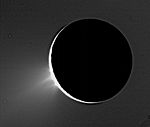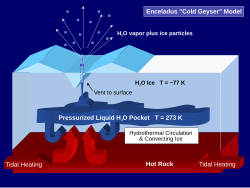| Revision as of 00:25, 24 October 2015 editOshwah (talk | contribs)Edit filter managers, Autopatrolled, Checkusers, Interface administrators, Oversighters, Administrators496,886 editsm Reverted edits by GalaxyStar91 (talk) (HG) (3.1.18)← Previous edit | Revision as of 20:51, 15 November 2015 edit undo65.175.246.43 (talk) →Observations: Possible cryovolcanoes on PlutoNext edit → | ||
| Line 18: | Line 18: | ||
| Indirect evidence of cryovolcanic activity was later observed on several other ]s of the ], including ], ], ], and ]. ''Cassini'' has observed several features thought to be cryovolcanoes on Titan, notably ], a feature regarded as "the very best evidence, by far, for volcanic topography anywhere documented on an icy satellite".<ref name="NASA statement">"". NASA, December 14, 2010</ref> Cryovolcanism is one process hypothesized to be a significant source of the methane found in Titan's atmosphere.<ref name="rain">{{cite web |title=Cassini Finds Hydrocarbon Rains May Fill The Lakes |author=Media Relations Office: Cassini Imaging Central Laboratory For Operations |publisher=Space Science Institute, Boulder, Colorado |date=2009 |url=http://ciclops.org/view.php?id=5471&js=1 |accessdate=4 March 2015}}</ref> | Indirect evidence of cryovolcanic activity was later observed on several other ]s of the ], including ], ], ], and ]. ''Cassini'' has observed several features thought to be cryovolcanoes on Titan, notably ], a feature regarded as "the very best evidence, by far, for volcanic topography anywhere documented on an icy satellite".<ref name="NASA statement">"". NASA, December 14, 2010</ref> Cryovolcanism is one process hypothesized to be a significant source of the methane found in Titan's atmosphere.<ref name="rain">{{cite web |title=Cassini Finds Hydrocarbon Rains May Fill The Lakes |author=Media Relations Office: Cassini Imaging Central Laboratory For Operations |publisher=Space Science Institute, Boulder, Colorado |date=2009 |url=http://ciclops.org/view.php?id=5471&js=1 |accessdate=4 March 2015}}</ref> | ||
| In 2007, observations by the ] showing patches of ammonia hydrates and water crystals on the surface of ]'s moon ] suggested the presence of active cryovolcanoes/cryogeysers.<ref name=ice>{{cite web|title=Charon: An ice machine in the ultimate deep freeze|work=Gemini Observatory|year=2007|url=http://www.spaceflightnow.com/news/n0707/17charon/|accessdate=18 July 2007}}</ref><ref>{{cite journal | url=http://www.iop.org/EJ/article/0004-637X/663/2/1406/70488.html | author=Cook | title=Near-Infrared Spectroscopy of Charon: Possible Evidence for Cryovolcanism on Kuiper Belt Objects | journal=The ] | volume=663 | issue=2 | pages=1406–1419 | year=2007 | doi=10.1086/518222 | last2=Desch | first2=Steven J. | last3=Roush | first3=Ted L. | last4=Trujillo | first4=Chadwick A. | last5=Geballe | first5=T. R. | bibcode=2007ApJ...663.1406C|display-authors=etal}}</ref> Subsequent observations by New Horizons in 2015 found that Charon has a youthful surface, supporting this idea.<ref>{{cite news |last=Beatty |first=Kelly |url=http://www.skyandtelescope.com/astronomy-news/charon-cracked-cratered-and-crazy-100220155/ |title=Charon: Cracked, Cratered, and Colorful |work=Sky and Telescope |date=2 October 2015 |accessdate=2015-10-03 }}</ref> Pluto itself is also |
In 2007, observations by the ] showing patches of ammonia hydrates and water crystals on the surface of ]'s moon ] suggested the presence of active cryovolcanoes/cryogeysers.<ref name=ice>{{cite web|title=Charon: An ice machine in the ultimate deep freeze|work=Gemini Observatory|year=2007|url=http://www.spaceflightnow.com/news/n0707/17charon/|accessdate=18 July 2007}}</ref><ref>{{cite journal | url=http://www.iop.org/EJ/article/0004-637X/663/2/1406/70488.html | author=Cook | title=Near-Infrared Spectroscopy of Charon: Possible Evidence for Cryovolcanism on Kuiper Belt Objects | journal=The ] | volume=663 | issue=2 | pages=1406–1419 | year=2007 | doi=10.1086/518222 | last2=Desch | first2=Steven J. | last3=Roush | first3=Ted L. | last4=Trujillo | first4=Chadwick A. | last5=Geballe | first5=T. R. | bibcode=2007ApJ...663.1406C|display-authors=etal}}</ref> Subsequent observations by New Horizons in 2015 found that Charon has a youthful surface, supporting this idea.<ref>{{cite news |last=Beatty |first=Kelly |url=http://www.skyandtelescope.com/astronomy-news/charon-cracked-cratered-and-crazy-100220155/ |title=Charon: Cracked, Cratered, and Colorful |work=Sky and Telescope |date=2 October 2015 |accessdate=2015-10-03 }}</ref> Pluto itself is also known to have several likely cryovolcanoes. <ref name = "Witze2015-11-09">{{cite web | ||
| | url = http://www.nature.com/news/icy-volcanoes-may-dot-pluto-s-surface-1.18756 | |||
| | title = Icy volcanoes may dot Pluto's surface | |||
| | last = Witze | first = A. | date = 2015-11-09 | website = Nature News and Comment | |||
| | publisher = ] | access-date = 2015-11-09}}</ref> | |||
| In 2015, two distinct bright spots inside a crater of the ] ] were imaged by the '']'' spacecraft, leading to speculation about a possible cryovolcanic origin.<ref name = "O'Neill2015.02.25">{{cite web | In 2015, two distinct bright spots inside a crater of the ] ] were imaged by the '']'' spacecraft, leading to speculation about a possible cryovolcanic origin.<ref name = "O'Neill2015.02.25">{{cite web | ||
Revision as of 20:51, 15 November 2015
| This article needs attention from an expert in Volcanoes or Solar System. Please add a reason or a talk parameter to this template to explain the issue with the article. WikiProject Volcanoes or WikiProject Solar System may be able to help recruit an expert. (February 2008) |

A cryovolcano (colloquially known as an ice volcano) is a volcano that erupts volatiles such as water, ammonia or methane, instead of molten rock. Collectively referred to as cryomagma or ice-volcanic melt, these substances are usually liquids and form plumes, but can also be in vapour form. After eruption, cryomagma condenses to a solid form when exposed to the very low surrounding temperature. Cryovolcanoes form on icy moons, and possibly on other low-temperature astronomical objects (e.g. Kuiper belt objects).
One potential energy source on some solar system bodies for melting ices and producing cryovolcanoes is tidal friction. It has also been suggested that translucent deposits of frozen materials could create a subsurface greenhouse effect that would accumulate the required heat.
Signs of past warming of the Kuiper belt object Quaoar have led scientists to speculate that it exhibited cryovolcanism in the past. Radioactive decay could provide the energy necessary for such activity, as cryovolcanoes can emit water mixed with ammonia, which would melt at 180 K (−95 °C) and create an extremely cold liquid that would flow out of the volcano.
Observations

Ice volcanoes were first observed on Neptune's moon Triton during a Voyager 2 flyby in 1989.
On November 27, 2005, Cassini photographed geysers on the south pole of Enceladus. (See also: Enceladus (Cryovolcanism).)
Indirect evidence of cryovolcanic activity was later observed on several other icy moons of the Solar System, including Europa, Titan, Ganymede, and Miranda. Cassini has observed several features thought to be cryovolcanoes on Titan, notably Sotra Patera, a feature regarded as "the very best evidence, by far, for volcanic topography anywhere documented on an icy satellite". Cryovolcanism is one process hypothesized to be a significant source of the methane found in Titan's atmosphere.
In 2007, observations by the Gemini Observatory showing patches of ammonia hydrates and water crystals on the surface of Pluto's moon Charon suggested the presence of active cryovolcanoes/cryogeysers. Subsequent observations by New Horizons in 2015 found that Charon has a youthful surface, supporting this idea. Pluto itself is also known to have several likely cryovolcanoes.
In 2015, two distinct bright spots inside a crater of the dwarf planet Ceres were imaged by the Dawn spacecraft, leading to speculation about a possible cryovolcanic origin.
Cryovolcanism on Enceladus-
 One possible scheme for Enceladus's cryovolcanism
One possible scheme for Enceladus's cryovolcanism
-
 Possible origins of methane found in plumes through its subsurface ocean
Possible origins of methane found in plumes through its subsurface ocean
-
 Chemical composition of the plumes of Enceladus
Chemical composition of the plumes of Enceladus
References
- ^ Darling, David (ed.). "Cryovolcanism". Internet Encyclopedia of Science.
- Jewitt, D.C.; J. Luu (2004). "Crystalline water ice on the Kuiper belt object (50000) Quaoar". Nature. 432 (7018): 731–3. Bibcode:2004Natur.432..731J. doi:10.1038/nature03111. PMID 15592406.. Reprint on Jewitt's site (pdf)
- Chang, Kenneth (March 12, 2015). "Suddenly, It Seems, Water Is Everywhere in Solar System". New York Times. Retrieved March 12, 2015.
- "Cassini Spots Potential Ice Volcano on Saturn Moon". NASA, December 14, 2010
- Media Relations Office: Cassini Imaging Central Laboratory For Operations (2009). "Cassini Finds Hydrocarbon Rains May Fill The Lakes". Space Science Institute, Boulder, Colorado. Retrieved 4 March 2015.
- "Charon: An ice machine in the ultimate deep freeze". Gemini Observatory. 2007. Retrieved 18 July 2007.
- Cook; Desch, Steven J.; Roush, Ted L.; Trujillo, Chadwick A.; Geballe, T. R.; et al. (2007). "Near-Infrared Spectroscopy of Charon: Possible Evidence for Cryovolcanism on Kuiper Belt Objects". The Astrophysical Journal. 663 (2): 1406–1419. Bibcode:2007ApJ...663.1406C. doi:10.1086/518222.
- Beatty, Kelly (2 October 2015). "Charon: Cracked, Cratered, and Colorful". Sky and Telescope. Retrieved 2015-10-03.
- Witze, A. (2015-11-09). "Icy volcanoes may dot Pluto's surface". Nature News and Comment. Nature Publishing Group. Retrieved 2015-11-09.
- O'Neill, I. (25 February 2015). "Ceres' Mystery Bright Dots May Have Volcanic Origin". Discovery Communications. Retrieved 1 March 2015.
External links
- Triton - Triton at the eight Planets
- South Pole of Triton - Triton at SolarViews.com
- Enceladus' South Polar Stripes Spew "Warm" Water - News article at the Planetary Society
- Cryovolcanism on Charon and other Kuiper Belt Objects
- Ice Volcanoes of Lake Superior's South Shore
- Dykes, Brett Michael (February 8, 2011). "Ice volcanoes are all the rage this winter: How do you stimulate a regional tourist economy?". The Lookout. Yahoo News. Retrieved February 8, 2011.
- Herzog, Karen (February 6, 2011). "Ice volcanoes attract curious explorers to Lake Michigan shore: Experts warn to explore formations with caution". Journal Sentinel. Retrieved February 8, 2011.